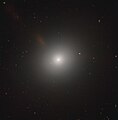پەڕگە:Messier105 - HST - Potw1901a.jpg

قەبارەی ئەم پێشبینینە: ٥٩١ لە ٥٩٩ پیکسەڵ. ڕێزەلووشنەکانی تر: ٢٣٧ لە ٢٤٠ پیکسەڵ | ٤٧٣ لە ٤٨٠ پیکسەڵ | ٧٥٨ لە ٧٦٨ پیکسەڵ | ١٬٠١٠ لە ١٬٠٢٤ پیکسەڵ | ٢٬٠٢٠ لە ٢٬٠٤٨ پیکسەڵ | ٧٬٥٧٢ لە ٧٬٦٧٦ پیکسەڵ.
پەڕگەی سەرەکی (٧٬٥٧٢ × ٧٬٦٧٦ پیکسڵ، قەبارەی پەڕگە: ١٥٫٨٣ مێگابایت، جۆری ئێم ئای ئێم ئی: image/jpeg)
مێژووی پەڕگە
کرتە بکە لەسەر یەکێک لە ڕێکەوت/کاتەکان بۆ بینینی پەڕگەکە بەو شێوەی لەو کاتەدا بووە.
| ڕێکەوت/کات | ھێما | ئەندازە | بەکارھێنەر | تێبینی | |
|---|---|---|---|---|---|
| هەنووکە | ٠٥:٢٣، ٧ی کانوونی دووەمی ٢٠١٩ |  | ٧٬٥٧٢ لە ٧٬٦٧٦ (١٥٫٨٣ مێگابایت) | Fabian RRRR | == {{int:filedesc}} == {{Information |description={{en|1=''' The heart of the Lion The heart of the Lion It might appear featureless and unexciting at first glance, but NASA/ESA Hubble Space Telescope observations of this elliptical galaxy — known as Messier 105 — show that the stars near the galaxy’s centre are moving very rapidly. Astronomers have concluded that these stars are zooming around a supermassive black hole with an estimated mass of 200 million Suns! This black hole releases hug... |
بەکارھێنانی پەڕگە
ئەم پەڕەیە ئەم پەڕگەیە بەکار دەھێنێت:
بەکارھێنانی سەرانسەریی پەڕگە
ئەم ویکیانەی دیکەی خوارەوەش ئەم پەڕگە بەکاردێنن:
- بەکارھێنان لە ar.wikipedia.org
- بەکارھێنان لە az.wikipedia.org
- بەکارھێنان لە be-tarask.wikipedia.org
- بەکارھێنان لە bn.wikipedia.org
- بەکارھێنان لە ca.wikipedia.org
- بەکارھێنان لە ce.wikipedia.org
- بەکارھێنان لە cs.wikipedia.org
- بەکارھێنان لە de.wikipedia.org
- بەکارھێنان لە diq.wikipedia.org
- بەکارھێنان لە en.wikipedia.org
- بەکارھێنان لە es.wikipedia.org
- بەکارھێنان لە et.wikipedia.org
- بەکارھێنان لە eu.wikipedia.org
- بەکارھێنان لە fr.wikipedia.org
- بەکارھێنان لە hu.wikipedia.org
- بەکارھێنان لە id.wikipedia.org
- بەکارھێنان لە it.wikipedia.org
- بەکارھێنان لە mg.wikipedia.org
- بەکارھێنان لە mk.wikipedia.org
- بەکارھێنان لە no.wikipedia.org
- بەکارھێنان لە simple.wikipedia.org
- بەکارھێنان لە tt.wikipedia.org
- بەکارھێنان لە vi.wikipedia.org
- بەکارھێنان لە www.wikidata.org
- بەکارھێنان لە zh-yue.wikipedia.org

